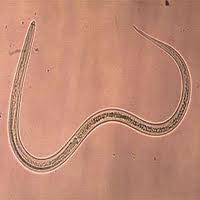Hookworm: Difference between revisions
No edit summary |
|||
| Line 15: | Line 15: | ||
===Description=== | ===Description=== | ||
The hookworm is a soil-transmitted helminth that is common in many third world and developing countries. There are two species that typically infect human beings—‘’N. americanus’’ and ‘’A. duodenale’’. Hookworms are located in areas with warm, moist climates. Most people with hookworm infections have no symptoms. A few do present symptoms. Serious effects of hookworm can lead to anemia and protein loss. | |||
==Pathogenesis== | ==Pathogenesis== | ||
===Transmission=== | ===Transmission=== | ||
Revision as of 11:43, 28 July 2014
Etiology/Bacteriology
Taxonomy
| Domain = Eukaryota | Phylum = Nematoda | Class = Secernentea | Order = Strongylida | Family = Ancylostomatidae | Genus = Necator/ Ancylostoma | species = [[ N. americanus/ A. duodenale]] [1, 2].
Description
The hookworm is a soil-transmitted helminth that is common in many third world and developing countries. There are two species that typically infect human beings—‘’N. americanus’’ and ‘’A. duodenale’’. Hookworms are located in areas with warm, moist climates. Most people with hookworm infections have no symptoms. A few do present symptoms. Serious effects of hookworm can lead to anemia and protein loss.
Pathogenesis
Transmission
Clinical Features
Diagnosis
Treatment
Prevention
Host Immune response
1. N americanus genome. http://www.ncbi.nlm.nih.gov/genome/?term=N+americanus
2. NCBI. http://www.ncbi.nlm.nih.gov/Taxonomy/Browser/wwwtax.cgi?name=Necator+americanus
3.
Created by Dane Korber


